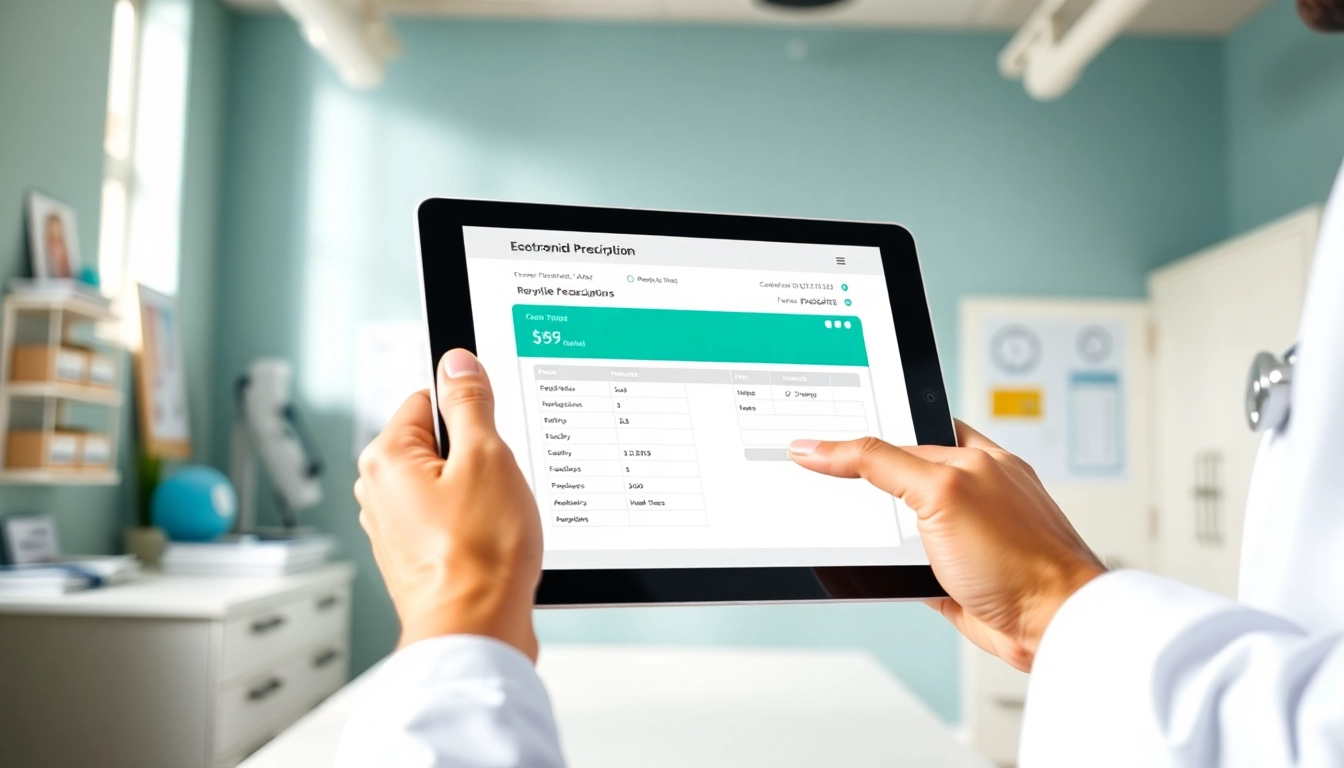In an era where technology continues to reshape the healthcare landscape, electronic prescribing (e-prescribing) applications are emerging as vital tools for medical professionals. From streamlining prescription workflows to enhancing patient safety, these applications are revolutionizing the way prescriptions are managed. This article explores what e-prescription apps are, their benefits, essential features, challenges faced in implementation, and future trends that promise to further enhance their utility. For healthcare professionals seeking to improve their prescribing processes, exploring the best eprescription apps can significantly facilitate better patient care.
What are Eprescription Apps?
Definition and Purpose
E-prescription apps are digital solutions that enable healthcare providers to write and transmit prescriptions electronically. Unlike traditional paper prescriptions, these apps allow physicians to send prescription details directly to pharmacies, minimizing the risk of errors and improving the efficiency of the prescribing process. The primary purpose of e-prescribing is to enhance patient safety and compliance while ensuring quick and secure communication between healthcare providers and pharmacies.
How Eprescription Apps Improve Patient Care
The introduction of e-prescribing in healthcare has led to numerous improvements in patient care. For instance, these apps help prevent medication errors by providing automatic checks for drug interactions and allergies. Moreover, they facilitate faster access to medications for patients, reducing delays that can occur due to handwriting errors or miscommunication. Additionally, e-prescription apps often include features that allow for better tracking of patient medication history, enhancing the ability to provide personalized care.
Key Features of Best Eprescription Apps
The best e-prescribing apps come equipped with a variety of features designed to enhance user experience and maximize efficiency. Key features include:
- User Authentication: Ensuring that only authorized personnel can access sensitive information.
- Medication Database: A comprehensive database that offers crucial information about prescribed medications, including dosages, side effects, and alternatives.
- Integration Capabilities: The ability to integrate seamlessly with electronic health records (EHR) and pharmacy management systems.
- Refill Requests: Functionality that allows pharmacists to process refill requests without needing direct communication with the provider.
- Analytics and Reporting: Tools that provide insights into prescribing patterns, enabling practices to review compliance and optimize treatments.
Benefits of Using Best Eprescription Apps
Efficiency in Prescription Management
One of the most significant benefits of adopting e-prescribing apps is the increased efficiency they bring to prescription management. Traditional methods often involve tedious paperwork and potential errors arising from misunderstood handwriting. With e-prescribing, healthcare providers can quickly enter and transmit prescriptions, reducing the time spent on administrative tasks. This efficiency allows healthcare professionals to focus more on patient care and interaction.
Enhanced Patient Safety and Compliance
E-prescribing apps contribute significantly to patient safety by automating checks for drug interactions and allergies. Such automatic alerts can prevent potential adverse drug events (ADEs) that may otherwise occur if prescriptions are processed without proper checks. Furthermore, e-prescribing formats encourage adherence to legal standards, thereby improving compliance rates with regulations, which is critical in maintaining patient safety.
Cost Savings for Practices
Utilizing e-prescription technology can lead to substantial cost savings for healthcare practices. By reducing paper usage, minimizing communication errors, and streamlining operations, practices can witness a decrease in the costs associated with prescription management. Additionally, by improving medication adherence through better accessibility, practices may also see fewer hospitalizations due to non-compliance, saving costs in emergency care.
Top Features to Look for in Best Eprescription Apps
User-Friendly Interface
A user-friendly interface is essential for any e-prescribing app, as it ensures that healthcare professionals can navigate the software efficiently without unnecessary frustration. An intuitive design allows for quick input and retrieval of information, which is vital in high-pressure clinical environments.
Integration with Other Health Systems
The ability to integrate with existing electronic health record systems, lab systems, and pharmacy networks is crucial. Effective integration allows for seamless data exchange, reducing the likelihood of errors and enabling a holistic view of the patient’s health information.
Mobile Accessibility
With the increasing reliance on mobile devices, ensuring that e-prescribing apps are mobile-friendly is becoming more important. Mobility allows healthcare providers to write and manage prescriptions from anywhere, providing flexibility and efficiency in patient care delivery. A well-designed mobile app can ensure quick access to medication management, even in outpatient settings.
Common Challenges and Solutions
Technical Issues and Support
Technical issues can hinder the effectiveness of e-prescribing systems. Problems such as software bugs, connectivity issues, or inadequate training can lead to frustration among users. To combat these challenges, it is vital for practices to have robust technical support available. Regular software updates and proactive system maintenance can also mitigate potential technical issues.
Training Staff on New Systems
Implementing a new e-prescribing system requires proper training to ensure that users can utilize it effectively. Conducting comprehensive training sessions and providing ongoing support resources can empower staff to adapt seamlessly to new systems. Workshops and hands-on training activities can be beneficial in promoting confidence and competence in using e-prescribing technologies.
Addressing Patient Concerns
Patients may have concerns regarding the privacy and security of their prescription data. Clear communication about how the e-prescribing system works, alongside robust data protection measures, can help alleviate these fears. Healthcare providers should take the initiative to educate patients about the advantages of e-prescribing, such as the reduction of errors and expedited medication access.
Future Trends in Eprescription Technology
AI and Machine Learning Applications
The integration of artificial intelligence (AI) and machine learning in e-prescribing apps is expected to transform the landscape of medication management. These technologies can enhance decision-making by analyzing patient data and providing personalized medication recommendations. AI-powered systems can also streamline workflows by predicting prescription needs and automating routine tasks.
Increased Remote Patient Management
As telemedicine continues to rise, e-prescribing apps are evolving to support remote patient management. Healthcare providers can prescribe medications electronically during virtual visits, ensuring continuity of care regardless of patient location. This trend not only enhances accessibility but also supports the ongoing management of chronic conditions.
Regulatory Changes and Compliance
Healthcare regulations regarding e-prescribing continue to evolve, and staying compliant with these regulations will be imperative for practices. The ongoing development of standards related to data security, interoperability, and patient rights will shape the future of e-prescribing technologies. Practices must stay informed about regulatory changes to maintain compliance and leverage advancements in e-prescribing effectively.



